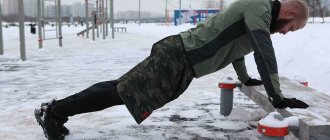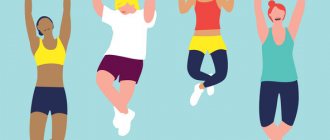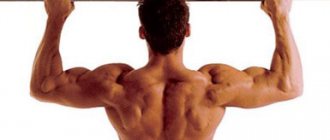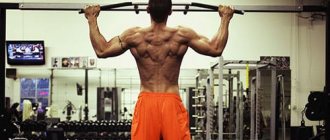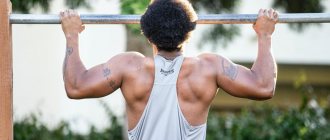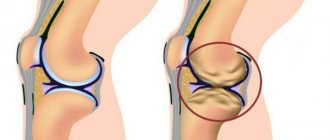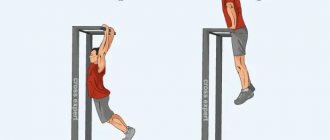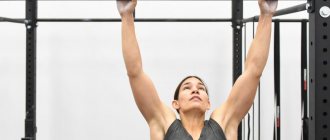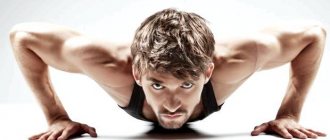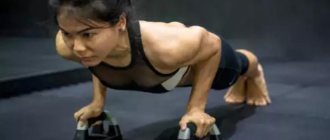Almost every yard has horizontal bars, where local youth often train and hone their skills in performing various physical exercises. Pull-ups are always a very popular exercise and an exciting competition: who is bigger?
Not everyone can do pull-ups, but everyone can learn to do 10-15 pull-ups. The only question is the effort and effort put in. But are you aware of the pitfalls that may surprise you unexpectedly? Let's talk about the benefits and, at the same time, the possible harm of pull-ups.
Curvature of the spine and poor posture
If you pull up incorrectly, it can cause a curvature of your spine. This threatens those who make the most common mistake - doing pull-ups with a jerk. The main thing in this exercise is to perform it smoothly, using your strength evenly.
The second very common mistake that can lead to another problem in the form of poor posture is doing pull-ups with uneven weight distribution. If you place a large load, for example, on your right hand, and use your left hand as an additional support point, then your posture will deteriorate over time. Yes, with this technology for performing pull-ups, you can do more than using two hands at the same time, but all this may not end very well for your health.
Beautiful back and slender arms: how to do pull-ups on the horizontal bar correctly
How to learn to do pull-ups? It is likely that this question worried you back in school, where pull-ups on the horizontal bar were a mandatory part of the program in physical education classes. If you still dream of learning how to confidently lift your body to the bar, then try to master this element with Sport24.
shutterstock.com
What are the benefits of pull-ups?
This classic exercise can bring serious benefits to your body:
- strengthen your back muscles;
- improve general sports training;
- use as many muscles as possible in your upper body.
Leading exercises to pull-ups on the horizontal bar
To quickly achieve your goal and master the correct execution of pull-ups, you should start with lead-up exercises. They will prepare your body and help you master the necessary technique.
1. Hanging on the bar
Hang on the bar and do not jump off it for as long as possible. The best option is 2-3 minutes. This conditioning exercise will strengthen your wrists and help the ligaments acclimate to your body weight. Important: even with a normal hang, the shoulders should be lowered, the back should remain straight, and the neck should not be pressed into the shoulders.
shutterstock.com
2. Shoulder engagement while hanging
Hang on the horizontal bar, your hands should be shoulder-width apart. Tighten your abdominal muscles, then lower your shoulders and squeeze your shoulder blades together. Hold the indicated position for 10-20 seconds, try to do 5-10 repetitions. This way you will increase your grip strength and master the correct starting position.
3. Hold at the top
Grab the horizontal bar, jump up and reach the top point - your chin should be above the horizontal bar. Hold this position for 40-60 seconds, perform the maximum number of repetitions.
4. Australian pull-ups
To perform this exercise, you will need a low bar - it should be located approximately at the level of your waist. Grab the horizontal bar, walk your feet under it so that you have to keep your balance with your hands. Pull yourself up to the bar, touch it with your chest, and return to the starting position. Perform 10 to 20 repetitions without bending or pushing your pelvis down.
5. Pull-ups with rubber bands
Fasten one end of the tape to the crossbar and secure the other to your leg. Pull yourself up. Perform 5 sets with as many reps as possible.
shutterstock.com
What is the best grip to use for pull-ups?
If you have mastered all the lead-up exercises and have been performing them regularly for a long time, it is time to move on to the pull-ups themselves. At this moment, you will definitely have a question regarding the grip - which one is correct and healthier for your body? It is recommended to start with an overhand grip and then use the one that best suits your training needs.
Direct grip - palms pointing away from you, the main part of the load falls on the latissimus dorsi and shoulders.
Reverse grip - palms are turned towards you, most of the load goes to the biceps, which help to reach the horizontal bar.
Mixed grip - one hand uses a forward grip and the other a reverse grip. You should not forget about changing hands in order to evenly work the muscles.
Neutral grip - the palms of the hands are parallel to each other, that is, directed towards each other (for this you need a special crossbar). The load is focused on the lower region of the latissimus muscles.
Grips are also divided according to the distance between the hands:
Narrow grip - the hands are located very close to each other, at a distance approximately equal to the width of the palm.
Wide grip - the hands are located at a distance approximately equal to one and a half shoulder lengths. Most of the load falls on the latissimus dorsi muscles.
Classic grip - hands are positioned shoulder-width apart; this grip is best suited for beginners.
shutterstock.com
How to do pull-ups on the horizontal bar?
Well, now it’s time for the pull-ups themselves. Follow these recommendations in this order:
- Hang from the horizontal bar.
- Initially, your shoulders should cover your ears, then lower your shoulders, squeeze your shoulder blades together, tighten your abs, move your pelvis back a little - this is the starting position.
- Pull yourself up until your chin goes beyond the level of the horizontal bar.
- Return to the starting position.
- After finishing the approach, rest for 1-2 minutes.
- Start with 5 sets of as many reps as possible.
- Train every other day to give your muscles a chance to recover.
shutterstock.com
What should you not do when doing pull-ups on a horizontal bar?
When performing pull-ups, strict adherence to the exercise technique is very important. This will allow you to extract maximum benefits for the body and maintain health.
- you cannot bend your legs to a right angle - this stretches the latissimus dorsi muscles and deprives them of some of their strength;
- do not relax your back while at the top point: the shoulder blades should be collected, the chest should be brought forward;
- do not swing or jerk - movements should be smooth, both when lifting the body and when descending;
- do not pull your chin up, trying to complete the approach: the head and neck do not change position until the end of the exercise;
- do not relax your shoulders at the lowest point, maintain the original tense position.
Maximum result
As the Chinese proverb says, in everything bad there is something good, so pull-ups also have their undeniable advantages and useful qualities. For example, among all the exercises that strengthen the arm muscles, push-ups give the maximum result. If you compare this exercise with push-ups, abs or anything else, then pull-ups really give the most results. But this is on one condition - if you perform this exercise correctly. So before you start doing pull-ups, it’s better to make sure how well you know the technique.
Frequency of classes
Do not overdo it with the number of repetitions and frequency of training.
Between classes you need to give your muscles time to recover, so it’s better to train no more than 2-3 times a week.
Therefore, before deciding where to buy a pull-up bar, you need to understand whether it is required at all or whether visits to the school sports ground will be enough.
Accelerating growth
Have you been short your whole life? It doesn’t matter, pull-ups will help speed up your growth (if you are under 25 years old). By doing this exercise, you stretch all your muscles, thus promoting your growth.
For girls, however, this method will not help, since most of the muscles are arranged differently in the female body. But pull-ups still provide general strengthening of posture to all people, regardless of their gender.
As you can see, this exercise has both its pros and cons. So the choice is yours whether it is worth doing or not. Provided all precautions are followed, there are undoubtedly many benefits from performing this element of physical training. But it is worth considering that the slightest mistake can lead to serious injuries, unlike other exercises. Therefore, calculate your strengths and capabilities, and also monitor your health after each workout.
Pull-ups for beginners
What types of pull-ups are there for beginners? Here are some simple tips for beginners on how to increase muscle strength with pull-ups and learn the correct movement.
Scapula activation
At the very beginning, first of all, you need to learn how to activate your shoulder blades. This means that you need to consciously connect them. It would be a good idea to see if you can do this while holding onto the bar.
It looks as if the person wants to push their chest forward while holding their arms up. This procedure allows you to increase the use of muscle fibers responsible for force during pull-ups.
- So the first step is to learn how to activate your back. During the test execution, you need to tense your abdominal muscles, lower your shoulder blades down and try to stay motionless on straight arms.
- It is this kind of hanging that is very useful for the spine, as they are unloaded, which brings tremendous relief and a feeling of lightness. This also strengthens your grip.
Negative pull-ups
The second step is to use negative pull-ups. They involve a very slow descent down, which requires keeping the body tense all the time until the elbows are completely straight.
It is a mistake not to perform the full range of motion in the elbow joint.
The negative phase is more important for building strength than the positive phase of the movement, so it is worth mastering.
Australian pull-ups
The third step is to perform the so-called Australian pull-ups (horizontal pull-ups on a low or medium bar). You need to choose a bar that is approximately at the level of your stomach.
- Place yourself under it so that the hands holding the bar are at the level of the pectoral muscles.
- You need to rest your feet on the ground, but your feet should be in a straight line.
- It is necessary to activate the shoulder blades, tighten the stomach and monitor the correct extension of the elbows.
- The correct angle to keep while performing the exercise is 45 degrees from the body.
A diagram of Australian pull-ups on the horizontal bar can be found on the Internet.
Pull-ups with elastic band
You can use special rubber training loops to make pull-ups easier. Gradually, when the exercise performed on the rubber becomes too easy, you can move on to the next (that is, thinner, less loaded) loop.
Rubber is used until they are no longer needed.
By the way, later these elastic bands can also be used for pull-ups on the horizontal bar, but to create a greater load when performing pull-ups.
Where should a beginner start to learn how to do pull-ups?
Rarely does anyone succeed in doing pull-ups the first time, so it is important for beginners not to force their body with excessive muscle tension. Unsuccessful, exhausting attempts to pull your chin up to the bar the first time in 99% of cases result in microtraumas, so you should give preference to a set of preparatory exercises.
First you need to master the technique of “negative repetitions”. The essence of this exercise is to assume a position as if the pull-up has already been completed and the body returns to its original position. To do this, you will need a horizontal bar and a low support (bench, stool, etc.). The main thing is that its height is just enough so that the athlete, standing on it, can calmly reach the horizontal bar with his chin.
The technique for performing negative repetitions is as follows:
- Starting position - standing on a chair, chin at the level of the horizontal bar, arms bent at the elbows and fixed at an average distance from each other on the bar.
- Next, the legs are bent so that the arms tense, holding the body in its original position.
- The arms are slowly straightened, as when coming out of a pull-up.
- Then the athlete returns to the starting position. If necessary, you can help yourself with your legs (lean them on a support) or ask an assistant to lift you from behind.
You shouldn’t overload yourself right away; 3 sets of 5 repetitions will be enough. It is not recommended to accelerate or sway while straightening your arms. All movements should be as smooth as possible.
Before starting training with pull-ups, it is advisable to warm up the muscles well and stimulate the cardiovascular system with a warm-up. But even here you should be restrained so as not to start the main training feeling tired.
Factors influencing the result
If you think that you can achieve good results with just training, then you are mistaken. Progress is influenced by many factors.
Firstly, nutrition. Your diet should be balanced in proteins, fats and carbohydrates and total calories.
How does nutrition affect increasing the number of pull-ups? The most direct. Food is fuel, energy for the body. During exercise, the body expends a large amount of energy to force the muscles to work. After performing exercises, the body experiences a greater need for energy, which must be replenished with the right food. Under this condition, the muscles will recover faster and better, which means you can start your next workout sooner.
Secondly, sleep. The average person should sleep 7-8 hours a day. This is especially true for people involved in sports. Sleep is the restoration of the whole body. During sleep, healthy hormones are produced that help repair both muscles and the entire body. The amount of sleep also directly affects the result, as does nutrition.
Thirdly, a competent approach to training. The basic rule: the next workout should be after complete muscle recovery. There is such a term as muscle overcompensation. It means an increase in muscle strength after recovery. Training is stressful for the body. And the body, so that this does not happen again, restores the muscles with a reserve, that is, increases their strength, so that next time it will be easier. That is why you should train only after overcompensation has occurred, that is, after complete recovery.
These are the main factors influencing progress. By following them, you can quickly increase the number of pull-ups on the horizontal bar. Of course, if you neglect any factor, such as nutrition, then progress can slow down significantly.
Grip width
The distance between your hands on the bar is also important to consider, especially for people who want to achieve specific training results. The effectiveness of the exercise and its effect on the development of individual muscle groups depend on the distance between the hands.
There are three grip width options:
- Narrow grip - hands are located at a distance of no more than 20 cm from each other. It's easier to do the technique. What muscles work when doing pull-ups on a horizontal bar with a narrow grip? This method uses the back muscles to a lesser extent, so pulling up will not affect the development of the upper back. Strongly activates the biceps and shapes the arm muscles.
- Medium grip - hands positioned slightly wider than shoulders. This is the best option if you want to harmoniously strengthen your arms and back because it works all muscles equally.
- A wide grip is a complex grip in which the hands are positioned at a distance much greater than shoulder width. With this grip, the latissimus dorsi muscle works the most. Recommended for men who want to develop their upper back. This gives the silhouette a V-shape.
Contraindications
Exercises on the horizontal bar have a small number of contraindications. People with diseases and disorders such as:
- Scoliosis (curvature of the spine);
- Herniated discs;
- Protrusion of the spine.
People with osteochondrosis should exercise on the horizontal bar with caution. On the one hand, exercises help to increase blood circulation and develop mobility of vertebral structures, on the other hand, excessive stress in case of degenerative changes in the vertebrae is contraindicated. People with osteochondrosis of the cervical spine should be especially careful: pull-ups can increase pain and cause dizziness.
source: https://yoursport.com
Execution options
- If you are a beginner and don’t have enough strength to complete the approach yet, train in the Gravitron simulator. With the help of the counterweight it uses, it will be easier to pull yourself up
- The exercise can also be performed with a partner who holds your legs and pushes you up
- You can complicate the movement by using weights - hanging discs or a dumbbell on a special belt
- To change the load angle, perform head pull-ups. But be careful, this option creates additional stress on the shoulder joint.
What muscles are involved when doing a pull-up?
Pull-ups involve almost the entire shoulder girdle and back, including small muscle groups that remain in a relaxed state during other types of loads.
This exercise is used to train the following muscle groups:
- targeted: latissimus dorsi muscles;
- synergizing: include the biceps, brachioradialis and brachialis muscles, teres major and minor, infraspinatus, middle and lower trapezius muscles, pectoralis minor, rhomboids, posterior deltoid, and levator scapulae;
- stabilizing: long head of the triceps.
Thus, it turns out that pull-ups that are ordinary at first glance can improve the growth of muscles throughout the upper body, chest, back, and arms.
Types of pull-ups depending on goals
There are different types of pull-ups, which are determined by the type of grip. Depending on the specific choice, the muscle group to be worked is determined.
For general physical development
The horizontal bar is a universal projectile. Pull-ups on the bar are performed with your own weight, which allows you to generally assess your physical fitness. Regular exercise makes it possible to get rid of physical weakness, as well as to develop techniques that will be most effective for muscle development. An optimally selected training regimen will increase endurance and strength. Classes should be carried out without fanaticism, so as not to harm the body.
For muscle growth
To gain mass, as with all exercises, you need to use weights.
There are general principles of implementation:
- The number of approaches should be from 4 to 6, and repetitions – 6 or 8 times, while performing pull-ups for strength. The weight needs to be distributed so that the last repetition is performed with all your might.
- The break between approaches should be no more than 3 minutes.
Perform the exercises without rocking. Movements should be slow, using only muscles (no jerking). Take a deep breath before starting, and exhale as you rise.
What hinders beginners
There are several factors that especially hinder beginners in their pursuits. This:
- Overweight . Excess mass creates extra stress on the muscles, even if they are sufficiently developed. If you have never played sports before, then you should not start right away with pull-ups - first you need to correct your weight with the help of diet and special “ground” exercises.
- Physical weakness. Even if your weight is normal, but your muscles are not developed enough, mastering pull-ups from scratch will not be easy. You should do some preliminary preparation of the body - developing strength and endurance.
- Weakness of accessory muscles. You should develop not only the main muscle groups (latissimus dorsi, biceps), but also the radial muscles, the posterior bundle of deltoid muscles, and the pectoral muscles.
- Undeveloped technology. The technical aspect must be constantly improved, otherwise the muscles will develop unevenly, and the ligaments, joints and bones will experience excessive stress.
Recommendations from professionals
- Don't rush and don't try to achieve results at any cost.
- To master pull-ups, first bend and straighten your arms while lying down, then do pull-ups on a low bar, and only then move on to a high bar.
- Abdominal exercises will also help you get used to exercise faster.
- Grasping the bar, smoothly pull your body up.
- Make sure that your elbows move down, slightly diverging to the sides.
- Shoulders need to be relaxed.
- Perform exercises without jerking.
- The rise and fall times should be approximately the same.
- Press the weights (pancakes suspended from the belt) with your feet. Use additional weights after the number of pull-ups has reached 10-12 repetitions.
- Use gloves. The best material is leather.
- Don't forget about proper breathing.
Following these simple recommendations will allow you to perform the exercises as effectively and safely as possible.

